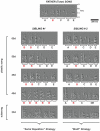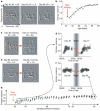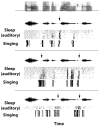Sleep, off-line processing, and vocal learning
- PMID: 19906416
- PMCID: PMC2891378
- DOI: 10.1016/j.bandl.2009.09.005
Sleep, off-line processing, and vocal learning
Abstract
The study of song learning and the neural song system has provided an important comparative model system for the study of speech and language acquisition. We describe some recent advances in the bird song system, focusing on the role of off-line processing including sleep in processing sensory information and in guiding developmental song learning. These observations motivate a new model of the organization and role of the sensory memories in vocal learning.
Copyright © 2009 Elsevier Inc. All rights reserved.
Figures






Similar articles
-
Auditory feedback in learning and maintenance of vocal behaviour.Nat Rev Neurosci. 2000 Oct;1(1):31-40. doi: 10.1038/35036205. Nat Rev Neurosci. 2000. PMID: 11252766 Review.
-
Memory in the making: localized brain activation related to song learning in young songbirds.Proc Biol Sci. 2010 Nov 7;277(1698):3343-51. doi: 10.1098/rspb.2010.0870. Epub 2010 Jun 9. Proc Biol Sci. 2010. PMID: 20534608 Free PMC article.
-
Song replay during sleep and computational rules for sensorimotor vocal learning.Science. 2000 Oct 27;290(5492):812-6. doi: 10.1126/science.290.5492.812. Science. 2000. PMID: 11052946
-
Auditory-vocal cholinergic pathway in the songbird brain.Can J Physiol Pharmacol. 2000 Dec;78(12):1072-6. Can J Physiol Pharmacol. 2000. PMID: 11149383
-
Mechanisms of song perception in oscine birds.Brain Lang. 2010 Oct;115(1):59-68. doi: 10.1016/j.bandl.2009.09.008. Epub 2010 May 14. Brain Lang. 2010. PMID: 20471673 Free PMC article. Review.
Cited by
-
Light, Sleep and Performance in Diurnal Birds.Clocks Sleep. 2021 Jan 28;3(1):115-131. doi: 10.3390/clockssleep3010008. Clocks Sleep. 2021. PMID: 33525352 Free PMC article. Review.
-
Multi-channel recordings reveal age-related differences in the sleep of juvenile and adult zebra finches.Sci Rep. 2023 May 27;13(1):8607. doi: 10.1038/s41598-023-35160-1. Sci Rep. 2023. PMID: 37244927 Free PMC article.
-
Representation of early sensory experience in the adult auditory midbrain: implications for vocal learning.PLoS One. 2013 Apr 24;8(4):e61764. doi: 10.1371/journal.pone.0061764. Print 2013. PLoS One. 2013. PMID: 23637903 Free PMC article.
-
Hippocampal memory consolidation during sleep: a comparison of mammals and birds.Biol Rev Camb Philos Soc. 2011 Aug;86(3):658-91. doi: 10.1111/j.1469-185X.2010.00165.x. Epub 2010 Nov 11. Biol Rev Camb Philos Soc. 2011. PMID: 21070585 Free PMC article.
-
Building a state space for song learning.Curr Opin Neurobiol. 2018 Apr;49:59-68. doi: 10.1016/j.conb.2017.12.001. Epub 2017 Dec 18. Curr Opin Neurobiol. 2018. PMID: 29268193 Free PMC article. Review.
References
-
- Appeltants D, Absil P, Balthazart J, Ball GF. Identification of the origin of catecholaminergic inputs to HVc in canaries by retrograde tract tracing combined with tyrosine hydroxylase immunocytochemistry. Journal of Chemical Neuroanatomy. 2000;18(3):117–133. Scopus. - PubMed
-
- Aronov D, Andalman AS, Fee MS. A specialized forebrain circuit for vocal babbling in the juvenile songbird. Science. 2008;320(5876):630–634. Scopus. - PubMed
Publication types
MeSH terms
Grants and funding
LinkOut - more resources
Full Text Sources

